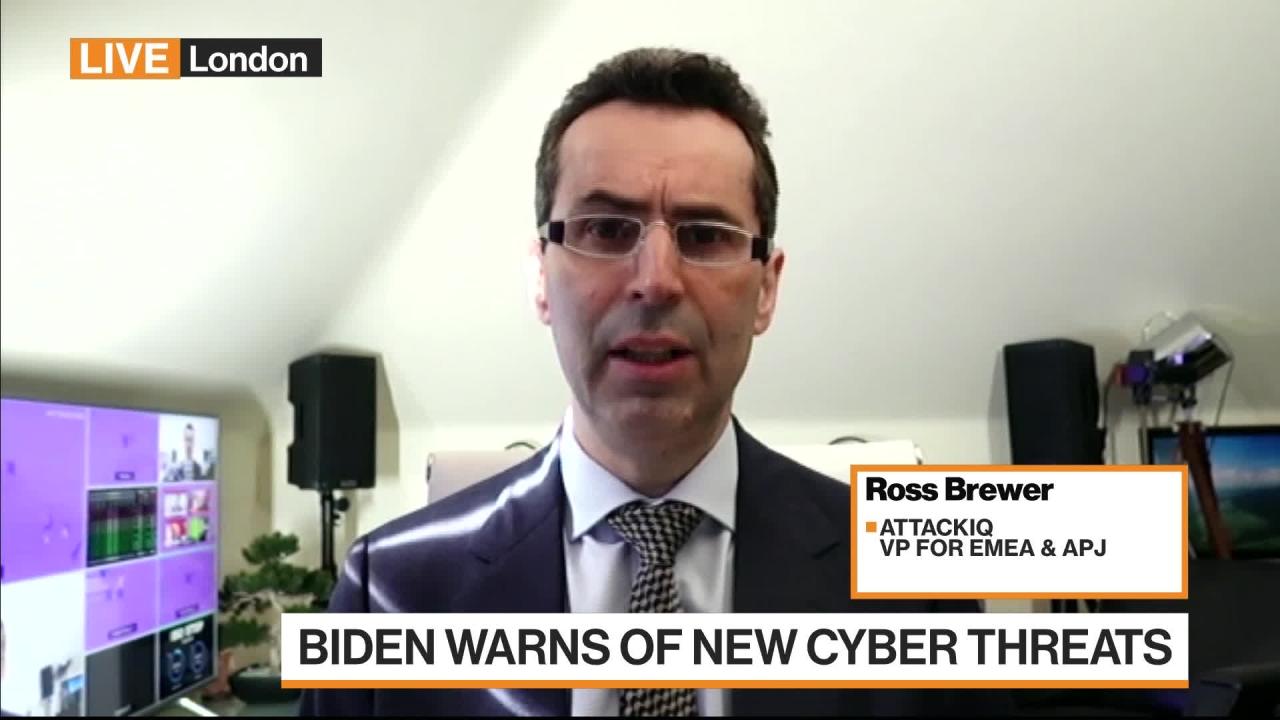
Britain on High Cybersecurity Alert Due to Russia
Britain on high cybersecurity alert due to Russia – that’s the headline grabbing everyone’s attention right now. The escalating cyber threat from Russia isn’t just a theoretical risk; it’s a very real and present danger impacting everything from critical national infrastructure to everyday businesses. We’re talking potential disruptions to power grids, financial systems, and even hospitals – all vulnerable to sophisticated cyberattacks.
This isn’t just a government problem; it’s a problem for all of us.
The UK government has responded by raising its cybersecurity alert level, implementing new countermeasures, and launching public awareness campaigns. But how effective are these measures? What can businesses and individuals do to protect themselves? And what does this mean for the future of cybersecurity in Britain? Let’s dive in and explore the current situation, potential impacts, and what steps we can all take to stay safe.
The Current Threat Landscape

The UK faces a persistent and evolving cyber threat landscape, with Russia identified as a key actor engaging in malicious cyber activities. These actions range from espionage and data theft to disruptive attacks targeting critical national infrastructure. Understanding the nature and scale of these threats is crucial for effective national security and resilience.
Russia’s cyber operations against the UK are multifaceted and sophisticated. They leverage a combination of state-sponsored actors and criminal groups, often blurring the lines between the two. This makes attribution challenging, but the consistent pattern of attacks targeting specific sectors and the sophistication of the techniques employed strongly suggest state involvement in many instances.
Specific Cyber Threats Posed by Russia to Britain
Russia’s cyber threats against the UK encompass a wide range of malicious activities. These include espionage aimed at stealing sensitive government information, intellectual property from private companies, and confidential data from research institutions. Beyond espionage, disruptive attacks targeting critical national infrastructure, such as energy grids, transportation networks, and healthcare systems, represent a significant concern. These attacks aim to cause widespread disruption and damage, potentially impacting essential services and national security.
Furthermore, disinformation campaigns, spread through social media and other online platforms, seek to sow discord and undermine public trust.
Potential Impact on Critical National Infrastructure
Successful cyberattacks against critical national infrastructure (CNI) could have severe consequences for the UK. Disruption to energy grids could lead to widespread power outages, impacting homes, businesses, and essential services. Compromised transportation networks could cause significant delays and disruptions, affecting the movement of goods and people. Attacks on healthcare systems could compromise patient data and disrupt essential medical services.
The overall impact could be economic instability, social unrest, and a significant blow to national security. For example, a successful attack on a major power grid could lead to widespread blackouts, causing billions of pounds in economic losses and potentially endangering lives.
Vulnerabilities Exploited by Russian Cyberattacks Against Britain
Russian cyberattacks often exploit known vulnerabilities in software and systems. Outdated software, insufficient security patching, and weak passwords are common targets. Phishing campaigns, designed to trick individuals into revealing sensitive information, are frequently used to gain initial access to systems. Exploiting vulnerabilities in supply chains is another tactic, allowing attackers to gain access to numerous organizations through a single compromised vendor.
The lack of robust cybersecurity practices across various sectors leaves the UK vulnerable to these attacks. A specific example could be an outdated industrial control system (ICS) in a power plant, vulnerable to remote access and manipulation.
Types of Cyberattacks Used by Russia Against Britain
The following table summarizes the types of cyberattacks, their targets, impact, and potential mitigation strategies:
| Attack Type | Target | Impact | Mitigation Strategy |
|---|---|---|---|
| Malware (e.g., wiper malware, ransomware) | Government agencies, critical infrastructure, private companies | Data loss, system disruption, financial losses, operational downtime | Robust endpoint security, regular software updates, network segmentation, data backups |
| Phishing | Individuals within organizations | Credential theft, malware infection, data breaches | Security awareness training, multi-factor authentication, email filtering |
| Denial-of-Service (DoS) | Websites, online services | Service disruption, loss of access, reputational damage | Distributed denial-of-service (DDoS) mitigation services, robust network infrastructure |
| Supply Chain Attacks | Third-party vendors, software suppliers | Compromise of multiple organizations, widespread data breaches | Thorough vendor risk assessment, secure software development practices, robust access controls |
Government Response and Preparedness
Britain’s heightened cybersecurity alert level, triggered by escalating tensions with Russia, underscores the seriousness of the threat. The government’s response reflects a multi-faceted approach aiming to bolster national resilience and mitigate potential damage from cyberattacks. This includes strengthening existing defenses, enhancing information sharing, and improving public awareness. The level of preparedness is significantly influenced by past experiences and lessons learned from previous cyber incidents.The current alert level, while not publicly specified in exact numerical terms, is understood to be elevated from the usual baseline.
This implies increased vigilance across critical national infrastructure, government departments, and private sector organizations deemed vital to national security. The implications are far-reaching, impacting everything from data protection and operational continuity to public trust and economic stability. A heightened alert necessitates increased monitoring, more stringent security protocols, and proactive threat hunting.
Cybersecurity Measures Implemented by the British Government
The government’s response involves a coordinated effort across multiple agencies. The National Cyber Security Centre (NCSC), part of GCHQ, plays a central role in providing guidance, support, and threat intelligence to organizations across the UK. This includes issuing advisories, providing vulnerability assessments, and deploying active defenses against known threats. Furthermore, the government is actively investing in advanced cyber security technologies and capabilities, including enhanced threat detection and response systems.
Significant resources are also dedicated to training and upskilling cybersecurity professionals. Increased collaboration with international partners, particularly those facing similar threats from state-sponsored actors, is another key component.
Government Initiatives to Improve National Cybersecurity Resilience
Several initiatives aim to improve national cybersecurity resilience. The NCSC’s active cyber defence program, for example, involves proactively identifying and disrupting malicious cyber activity before it can cause significant harm. The government also supports schemes that encourage businesses, particularly SMEs, to adopt better cyber security practices. This includes providing resources, training, and financial incentives to enhance their defences. Public awareness campaigns aim to educate citizens about online safety and the importance of reporting suspicious activity.
The development and implementation of national cybersecurity standards and frameworks also contribute to a more resilient overall system.
Comparison with Previous Responses to Similar Threats, Britain on high cybersecurity alert due to russia
The current response to the heightened threat from Russia builds upon past experiences. Previous incidents, such as the NotPetya ransomware attack in 2017, highlighted vulnerabilities within critical infrastructure and the need for improved information sharing and collaboration. The response to the current threat reflects a more proactive and coordinated approach, with a greater emphasis on threat intelligence, proactive defence, and public-private partnerships.
While the scale and specifics of the threat differ, the government’s approach emphasizes lessons learned from past crises to create a more robust and resilient cybersecurity posture.
Impact on Businesses and Critical Infrastructure
The heightened cybersecurity alert in Britain due to the increased threat from Russia poses significant risks to businesses of all sizes, particularly those holding sensitive data or operating critical infrastructure. The potential for disruption, financial loss, and reputational damage is substantial, demanding a proactive and comprehensive approach to cybersecurity. Understanding the vulnerabilities and implementing robust protective measures are crucial for survival in this heightened threat environment.The potential impact of sophisticated cyberattacks originating from Russia could range from data breaches and ransomware attacks to complete system shutdowns and operational paralysis.
The economic consequences could be devastating, impacting not only individual businesses but also the wider UK economy. The scale of the potential damage underscores the urgent need for businesses to prioritize cybersecurity.
Sectors Most Vulnerable to Russian Cyberattacks
Certain sectors are inherently more vulnerable to Russian cyberattacks due to the nature of their operations and the value of their data. These include financial institutions, energy providers, telecommunications companies, and government contractors. These sectors often possess critical infrastructure and sensitive data that are highly attractive targets for state-sponsored cyber actors aiming to disrupt essential services or steal valuable information for geopolitical advantage.
Furthermore, healthcare providers, manufacturing facilities, and transportation networks are also at risk, highlighting the widespread nature of the threat. The interconnectedness of modern systems means a successful attack on one entity could have cascading effects across multiple sectors.
Steps Businesses Should Take to Protect Themselves
Businesses must adopt a multi-layered approach to cybersecurity to effectively mitigate the risks. This begins with a thorough risk assessment to identify vulnerabilities and prioritize mitigation efforts. Investing in robust security technologies, such as firewalls, intrusion detection systems, and endpoint protection software, is crucial. Regular security audits and penetration testing can identify weaknesses before malicious actors exploit them.
Employee training is paramount, as human error remains a significant vulnerability. Employees need to be educated on phishing scams, social engineering tactics, and safe password practices. Furthermore, incident response planning is essential to ensure a swift and effective response in the event of a cyberattack. This includes establishing clear communication protocols and procedures for containing and remediating incidents.
Best Practices for Enhancing Cybersecurity Posture
A robust cybersecurity posture requires a multifaceted approach. Here are some key best practices:
- Implement multi-factor authentication (MFA) for all user accounts to enhance access control.
- Regularly update software and operating systems to patch known vulnerabilities.
- Develop and regularly test a comprehensive incident response plan.
- Conduct regular employee security awareness training to mitigate human error.
- Employ robust data loss prevention (DLP) measures to protect sensitive information.
- Segment networks to limit the impact of potential breaches.
- Utilize strong, unique passwords and encourage password managers.
- Back up data regularly and securely to ensure business continuity.
- Monitor network activity for suspicious behavior and promptly investigate any anomalies.
- Consider cybersecurity insurance to mitigate financial losses in the event of a breach.
Public Awareness and Education
Public awareness plays a crucial role in mitigating cyber threats. A well-informed public is less likely to fall victim to phishing scams, malware attacks, and other online threats. Increased awareness empowers individuals and organizations to proactively protect themselves and report suspicious activity, strengthening the overall cybersecurity posture of the nation. This is especially vital during heightened alert levels like the current situation with Russia.The government’s role in fostering public awareness is paramount.
Effective communication can significantly reduce the impact of cyberattacks.
Government Public Awareness Campaigns
The UK government has launched several public awareness campaigns over the years focusing on various aspects of online safety and cybersecurity. These campaigns often utilize various media channels, including television, radio, online advertisements, and social media platforms. Recent campaigns have emphasized the importance of strong passwords, recognizing phishing attempts, and being cautious about clicking on unknown links. Specific campaign details, including slogans and visuals, are often kept confidential to maintain effectiveness and prevent attackers from exploiting the campaign’s information.
However, the overarching themes generally focus on simple, actionable steps individuals can take to improve their online security. The campaigns are often adapted and updated to reflect current threats and vulnerabilities.
Public Service Announcement (PSA)
The current threat landscape necessitates immediate action. Russia’s heightened cyber activity poses a significant risk to individuals and organizations across the UK. To protect yourself, take these steps:* Be vigilant: Scrutinize emails and messages carefully. Be wary of unsolicited links or attachments. If something seems suspicious, don’t click on it.
Use strong passwords
Employ unique, complex passwords for all your online accounts. Consider using a password manager to help you manage them securely.
Keep your software updated
Regularly update your operating systems, applications, and antivirus software. This patches security vulnerabilities that attackers could exploit.
Be cautious online
Avoid sharing personal information online unless absolutely necessary. Be aware of your surroundings when using public Wi-Fi.
Report suspicious activity
If you suspect you’ve been a victim of a cyberattack, report it to the relevant authorities immediately. The National Cyber Security Centre (NCSC) website provides guidance and reporting mechanisms.
Effective Cybersecurity Education Initiatives
Effective cybersecurity education for the general public requires a multi-faceted approach. Simple, easily digestible information is key. The NCSC’s website provides a wealth of resources, including guides and toolkits for individuals and businesses. Many organizations offer free online courses and workshops on cybersecurity best practices. These initiatives often utilize interactive modules and real-world scenarios to engage learners and make complex topics more accessible.
Schools and universities also play a critical role in educating younger generations about online safety and responsible digital citizenship. Regular public awareness campaigns, supported by clear and concise messaging, are also vital for maintaining a high level of public awareness and preparedness. Examples include simulated phishing attacks to educate users on recognizing and reporting such attempts. The success of these initiatives can be measured by tracking reported incidents and evaluating user behaviour changes following educational campaigns.
International Cooperation and Allies
The escalating cyber threat landscape, particularly from state-sponsored actors like Russia, necessitates a robust international response. No single nation possesses the resources or expertise to effectively combat these sophisticated attacks alone. Therefore, collaborative efforts and intelligence sharing among allies are paramount to mitigating risks and building collective resilience.Britain’s response to Russian cyberattacks relies heavily on strong partnerships. This isn’t merely a matter of sharing information; it involves coordinated strategies, joint exercises, and the development of shared defensive capabilities.
With Britain on high cybersecurity alert due to escalating tensions with Russia, robust digital defenses are more critical than ever. Building secure and efficient applications is key, and that’s where exploring options like domino app dev the low code and pro code future becomes incredibly relevant. Understanding these modern development approaches could be vital in bolstering our national cyber resilience against potential threats from Russia.
The collaborative nature of this effort ensures a more effective and comprehensive response than any nation could achieve independently.
Intelligence Sharing Mechanisms
Effective countermeasures against sophisticated cyberattacks hinge on timely and accurate intelligence. Britain actively participates in several intelligence-sharing alliances, exchanging information on malicious actors, attack techniques, and vulnerabilities. This collaborative intelligence gathering allows for quicker identification of threats, improved threat prediction, and more effective preventative measures. For instance, the sharing of indicators of compromise (IOCs) – specific pieces of data that suggest a system has been compromised – allows nations to proactively defend against ongoing attacks.
The Five Eyes alliance (Australia, Canada, New Zealand, the UK, and the US) provides a particularly strong framework for this type of collaboration, facilitating the rapid exchange of sensitive information. Beyond the Five Eyes, Britain works closely with NATO and the EU to enhance intelligence sharing and coordinated responses.
Comparative National Cyber Security Strategies
Different nations adopt varied approaches to cybersecurity, reflecting their unique geopolitical situations and technological capabilities. While the core principles of threat detection, prevention, and response remain consistent, the specific strategies and priorities differ. For example, the US emphasizes a strong private-sector role in cybersecurity, whereas some European nations prioritize a more regulatory approach. However, there is a growing convergence towards a more collaborative, internationally coordinated approach, recognizing the transnational nature of cyber threats.
This convergence is evidenced by the increasing number of joint cybersecurity exercises and initiatives, designed to improve interoperability and coordination in responding to cyber incidents. The sharing of best practices and lessons learned from past attacks is also crucial in strengthening collective defences. For example, the response to the NotPetya ransomware attack, attributed to Russia, highlighted the need for improved international collaboration in incident response and attribution.
Technological Countermeasures: Britain On High Cybersecurity Alert Due To Russia

The UK’s heightened cybersecurity alert necessitates a robust technological response to the escalating threat from Russia. This involves a multi-layered approach leveraging advanced technologies to detect, prevent, and mitigate sophisticated cyberattacks. The effectiveness of these measures relies heavily on continuous adaptation, proactive threat hunting, and strong collaboration between government, private sector, and international partners.Advanced technologies play a crucial role in defending against increasingly complex cyber threats.
These technologies are not simply implemented and forgotten; they require constant monitoring, updating, and refinement to remain effective against evolving attack vectors. Furthermore, the human element – skilled cybersecurity professionals – remains vital in interpreting data, responding to incidents, and developing new strategies.
With Britain on high cybersecurity alert due to escalating tensions with Russia, robust security measures are more critical than ever. This highlights the importance of solutions like cloud security posture management, and learning more about platforms such as bitglass and the rise of cloud security posture management is key to understanding how to better protect sensitive data.
Ultimately, strengthening our digital defenses is paramount in the face of such threats to national security.
Threat Detection and Prevention Technologies
Modern cybersecurity relies on a combination of technologies working in concert. Intrusion Detection and Prevention Systems (IDPS) monitor network traffic for malicious activity, while Security Information and Event Management (SIEM) systems collect and analyze security logs from various sources to identify patterns and anomalies indicative of attacks. Advanced threat intelligence platforms provide crucial context, enabling proactive threat hunting and faster response times.
Furthermore, endpoint detection and response (EDR) solutions monitor individual devices for malicious activity, offering granular visibility and control. These technologies are implemented through a combination of hardware, software, and skilled personnel. Regular updates and patches are crucial to maintain effectiveness.
Implementation and Maintenance
The implementation and maintenance of these technologies are complex and require specialized expertise. This includes network infrastructure upgrades, software installations and configurations, and the development of robust incident response plans. Regular security audits, penetration testing, and vulnerability assessments are vital to identify and address weaknesses. The human element is paramount; skilled security analysts are needed to monitor alerts, investigate incidents, and respond effectively.
Furthermore, ongoing training and professional development are essential to maintain the necessary expertise to manage and adapt these technologies.
Successful Applications
While specific details of successful countermeasures are often kept confidential for security reasons, publicly available information highlights the effectiveness of these technologies. For example, the detection and disruption of ransomware attacks targeting critical infrastructure often involve the coordinated use of SIEM, threat intelligence, and EDR solutions. Similarly, the identification and neutralization of sophisticated phishing campaigns relies heavily on advanced threat detection technologies and employee training.
The effectiveness of these countermeasures often depends on rapid response and effective collaboration between organizations.
Technologies Used in Countering Cyber Threats
| Technology | Function | Strengths | Weaknesses |
|---|---|---|---|
| Intrusion Detection/Prevention Systems (IDPS) | Monitor network traffic for malicious activity; block or alert on suspicious behavior. | Real-time threat detection; can prevent attacks before they impact systems. | Can generate false positives; requires regular updates to remain effective; may not detect sophisticated, zero-day exploits. |
| Security Information and Event Management (SIEM) | Collect and analyze security logs from various sources; identify patterns and anomalies indicative of attacks. | Provides comprehensive security visibility; facilitates threat hunting and incident response. | Can be complex to implement and manage; requires significant storage capacity; can be overwhelmed by large volumes of data. |
| Endpoint Detection and Response (EDR) | Monitor individual devices for malicious activity; provide granular visibility and control. | Offers detailed insights into endpoint behavior; enables rapid incident response; can detect and remediate threats that bypass network-based security controls. | Can impact system performance; requires significant expertise to manage and interpret data; may not be effective against sophisticated, targeted attacks. |
| Advanced Threat Intelligence Platforms | Provide real-time threat information and context; enable proactive threat hunting and faster response times. | Improves threat detection accuracy; facilitates faster response to emerging threats; enables proactive security measures. | Relies on accurate and timely threat intelligence feeds; can be expensive; requires skilled analysts to interpret and act on the intelligence. |
Long-Term Implications and Future Preparedness
The heightened cybersecurity alert stemming from Russian aggression highlights a crucial need for Britain to fundamentally rethink its long-term approach to digital security. This isn’t just about reacting to immediate threats; it’s about building a resilient and adaptable system capable of withstanding future, potentially more sophisticated, attacks. The economic and societal consequences of a major cyberattack could be devastating, impacting everything from critical national infrastructure to individual citizens’ privacy and data security.
Therefore, a proactive and comprehensive strategy is paramount.The long-term implications extend beyond immediate damage control. A successful attack could erode public trust in digital systems, hindering economic growth and potentially destabilizing essential services. Furthermore, the cost of remediation and recovery following a major incident could be astronomical, placing a significant burden on both the public and private sectors.
The ongoing arms race in cyber warfare necessitates a continuous cycle of adaptation and innovation in defence mechanisms.
Strengthening National Cybersecurity Infrastructure
Investing in robust and resilient cybersecurity infrastructure is not merely an expense; it’s an investment in national security and economic stability. This requires a multi-faceted approach, encompassing the modernization of existing systems, the implementation of advanced threat detection and response capabilities, and the development of a national cybersecurity reserve capable of rapidly deploying expertise during crises. For example, upgrading critical infrastructure systems to incorporate zero-trust architectures, which limit access based on least privilege, could significantly mitigate the impact of successful breaches.
The UK government should prioritize funding for initiatives that promote the adoption of these advanced security measures across all sectors.
Developing and Retaining Cybersecurity Expertise
A critical component of long-term cybersecurity resilience is the development and retention of highly skilled cybersecurity professionals. This involves investing in education and training programs at all levels, from primary and secondary schools to universities and professional development initiatives. A concerted effort is needed to attract and retain talent within the cybersecurity field, potentially through competitive salaries, attractive benefits packages, and opportunities for career advancement.
This might involve partnerships with universities to establish dedicated cybersecurity research centers and scholarship programs to attract promising students. Furthermore, ongoing professional development is crucial to ensure that professionals stay abreast of the latest threats and technologies.
Timeline for Enhancing Cybersecurity Preparedness
The following timeline Artikels key steps for strengthening Britain’s future cybersecurity preparedness:
This timeline is a suggestion and specific dates and priorities will need to be adjusted based on ongoing threat assessments and resource availability.
| Year | Key Actions |
|---|---|
| 2024 | Complete national cybersecurity infrastructure audit; initiate pilot programs for zero-trust architecture implementation in critical infrastructure; launch large-scale public awareness campaign. |
| 2025 | Begin nationwide rollout of zero-trust architecture; establish national cybersecurity reserve; significantly increase funding for cybersecurity education and training programs. |
| 2026-2030 | Continue investment in infrastructure and personnel; develop and implement advanced threat intelligence sharing mechanisms; foster international collaboration on cybersecurity standards and best practices; regularly review and update national cybersecurity strategy. |
Wrap-Up
The heightened cybersecurity alert in Britain due to Russian cyber threats underscores the urgent need for robust national defense and proactive individual measures. While the government is taking steps to mitigate risks, the responsibility for cybersecurity extends to every citizen and business. Staying informed, practicing safe online habits, and implementing strong security measures are crucial for safeguarding against increasingly sophisticated cyberattacks.
The long-term implications of this situation highlight the ongoing need for investment in cybersecurity infrastructure, personnel training, and international collaboration to combat this evolving threat landscape.
FAQ Guide
What specific types of malware are being used in these attacks?
Reports indicate a variety of malware, including sophisticated custom-built tools designed to specifically target UK infrastructure, alongside more widely used strains adapted for this purpose. Specific details are often kept confidential for national security reasons.
How can I tell if I’m being targeted by a Russian cyberattack?
It’s difficult to know for certain without specialized security monitoring. However, suspicious emails, unusual activity on your accounts, or slowdowns/interruptions in online services could be warning signs. Report anything unusual to the relevant authorities immediately.
Are my personal data at risk?
Yes, personal data is always at risk from cyberattacks. Strong passwords, multi-factor authentication, and regular software updates are crucial to minimize this risk. Be wary of phishing attempts and avoid clicking suspicious links.
What is the government doing to help businesses?
The government is offering guidance, support, and resources to help businesses improve their cybersecurity defenses. They’re also working with key sectors to identify vulnerabilities and implement preventative measures. Check the NCSC (National Cyber Security Centre) website for the latest information.





